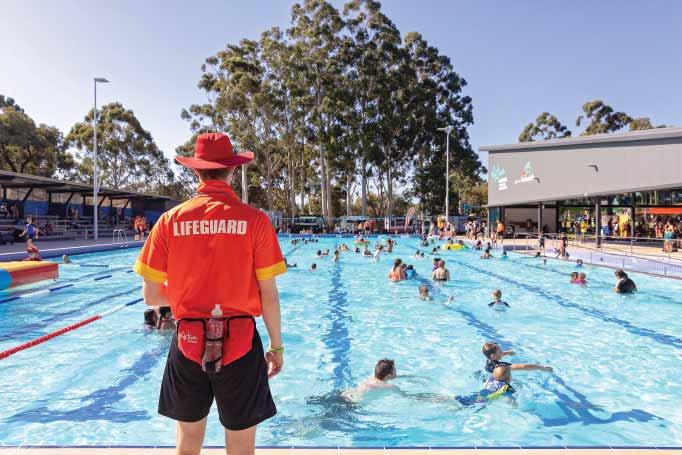
3 minute read
Robust State
Armadale Fitness and Aquatic Centre (above) and the Cockburn ARC (below).
Findings from Western Australia’s latest ‘Bigger, Better, Safer’ report
Advertisement
A newly released report from Royal Life Saving Society WA, in conjunction with LIWA Aquatics, shows that public aquatic facilities in Western Australia recorded 10.4 million visits in 2020/21 - representing 3.9 pool visits per head of population.
A decline from a pre-COVID peak of 11.5 million visits on 2018/19, these visits have been shown to deliver $275 million in economic benefits to the state.
Breaking down the visits, the ‘Bigger, Better, Safer: Western Australian Aquatics Industry Report 2020/21’, showed that 412,906 visits to facilities in the Mid West region - equating to 7.8 visits per head - was the highest in the state while 192,450 in the Great Southern region - equating to 3.1 visits per head - was the lowest.
Aquatic industry expenditure totalled $96.1 million total in 2020/21, an 18.8% rise from 2019/20 with an average $9.22 expenditure per public pool visit during the year. The Pilbara region was the highest spending, generating $24.50 per visit while Metropolitan Perth had the lowest at $7.60 per visit.
The annual report on the state of the aquatic industry in Western Australia, showed 4134 staff were employed in 2020/21 of which 738 were full-time, 446 part-time and 2950 casuals - with 60% of this workforce located in Metropolitan Perth.
The 18 to 24 years age group were the largest part of the workforce (38%) while the 25 to 34 and 55 to 64 age groups totalled 13% each. 64% of this workforce were female, 1.45% came from Aboriginal and/ or Torres Strait Islander and 2% from multicultural backgrounds.
Technical staff in pools made up 11% of the workforce, 40% of whom worked in the Perth area. With an average age of 37 years, 35% were employed on a casual basis.
Pool lifeguards made up 28% of the workforce, 73% of whom worked in the Perth area. With an average age of 26 years, 68% were employed on a casual basis.
In these groups, 70% of technical staff and 54% of lifeguards were male.
Swim teachers made up 33% of the workforce, 78% of whom worked in the Perth area. With an average age of 26 years, 86% were employed on a casual basis and 75% of this segment of the workforce female.
The report, which as far back as its 2017/18 edition identified the now nationwide trend of a shortage of swim instructors and pool lifeguards, showed in this latest edition that there are a total of 1377 swim instructor positions in the state, not all of which are currently filled.
Among the active positions, 133 are swim coaches and 735 are swim teachers.
Reversing a trend of decreasing water usage over recent years, water consumption across facilities rose to a total of 1270 megalitres, an increase of 1.1% from the previous years, with an estimated 123 litres water consumption per patron.
In the area of safety, ‘Bigger, Better, Safer’ recorded 2,327 injuries at public pools in 2020/21, representing 22.3 incidents per 100,000 visits.
Trips, slips and falls were the major incidents and cuts, grazes and piercings the main injuries.
Produced each year with financial assistance from the Western Australian Department of Sport and Recreation, ‘Bigger, Better, Safer’ report aims to: -Better understand the aquatic industry as a collective and to quantify key outputs, -Monitor risks to patron safety and identify trends, -Evaluate compliance to industry benchmarks and standard operating procedures, and -Be a catalyst for discussion and an evidence base for ongoing program development.
Overall, the report states “aquatic centres provide significant benefits to the WA community, in terms of community development, sport, recreation, health and fitness.”
Moving forward it suggests: improving injury data procedures across the state; continuing efforts to reduce injury at public pools; improving cultural knowledge across workforce; further exploration into facility expenditure; assessing the social impact of aquatic facilities and addressing workforce staffing gaps.
In regard to staffing issues, it notes “currently, the industry is struggling to find staff to meet the demands for swimming instructors and lifeguards during peak time periods and across regional WA.
“Further efforts are needed to encourage individuals to join the aquatic industry workforce and decrease staff turnover. This is particularly important in regional WA where programs have been cancelled due to a lack of available staff.”











